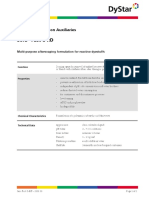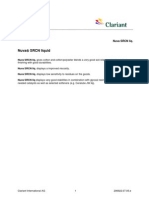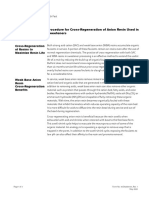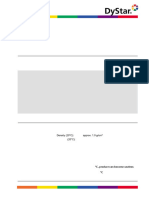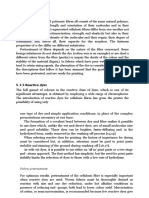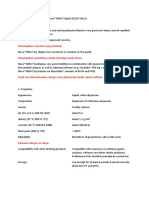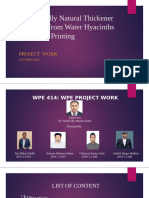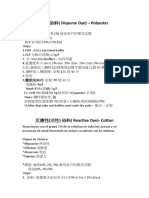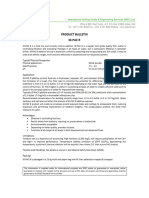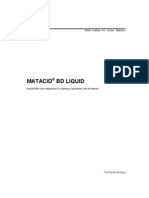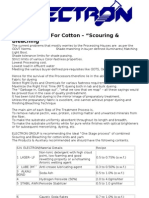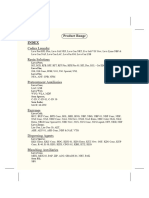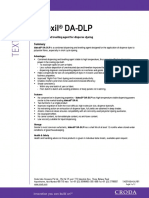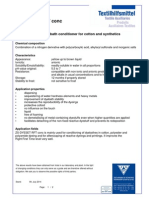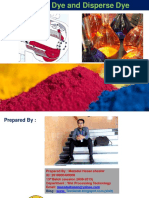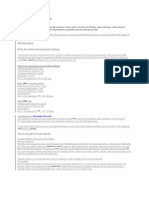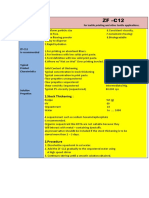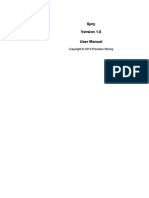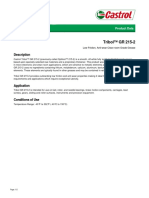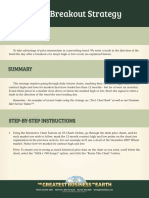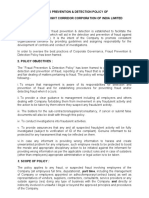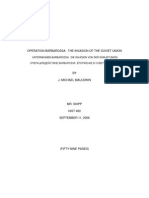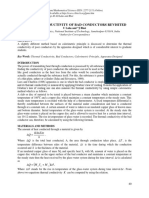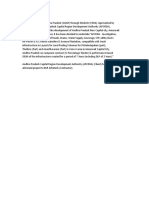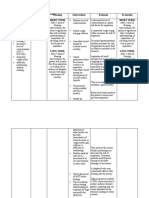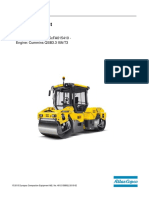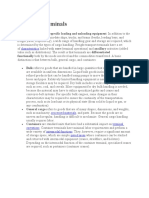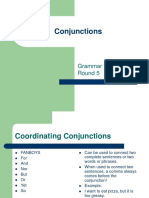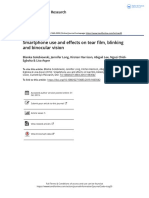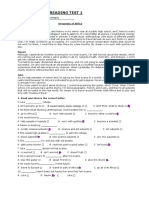DSL Fast C-Rd-Tds 19
DSL Fast C-Rd-Tds 19
Uploaded by
Sajib TonmoyCopyright:
Available Formats
DSL Fast C-Rd-Tds 19
DSL Fast C-Rd-Tds 19
Uploaded by
Sajib TonmoyOriginal Title
Copyright
Available Formats
Share this document
Did you find this document useful?
Is this content inappropriate?
Copyright:
Available Formats
DSL Fast C-Rd-Tds 19
DSL Fast C-Rd-Tds 19
Uploaded by
Sajib TonmoyCopyright:
Available Formats
Product Information Process Auxiliaries
DSL Fast C-RD
Highly effective after soaping formulation for reactive dyeings
Function Washing accelerator for removal of unfixed reactive dyestuffs from cellu-
losic fibers and blends with synthetic fibers after dyeing or printing
Properties - removes unfixed hydrolised dyestuff from the fiber and keeps it in
solution
- prevents re-exhaustion of hydrolised and unfixed dyestuff onto the
fiber
- independent of pH, salt concentration and water hardness
- reduces the total water consumption
- suitable for continuous and discontinuous processes
- low foaming
Chemical Characteristics Formulation of a polymeric carboxylic acid derivative
Technical Data Appearance: slightly yellowish liquid
pH: approx. 6 - 8 (10% solution)
Density (20 °C): 1.0 - 1.1 g/cm³
Ionicity: weakly anionic
Dilution procedure: easily soluble in water
Shelf life: 24 months in closed original containers
DSL Fast C-RD - 2017/09 Page 1 of 4
Application
To remove unfixed reactive dye from the dyed fiber it is first necessary
to dilute the electrolyte to a concentration below 2.0 g/l before soaping.
Where possible rinsing should be hot to maintain the open structure of the
cellulose fiber and allow effective diffusion-out of the dye hydrolisate.
With Remazol® dyes the first rinse in the presence of residual alkali
should be at 30 - 50 °C to avoid hydrolysing the vinyl-sulphone
cellulose covalent bond. After this initial rinse a neutralization stage
using acetic acid at pH of 5 - 6 for 10 minutes at 50 - 80 °C should be
given, after which hot rinsing and soaping can be carried out.
The number of rinses before the soaping depends on the depth of
shade, liquor carry-over, and liquor ratio (refer to DyStar reactive
dye pattern card)
- The number of rinse bathes No. 4 depend on depth of shade, on liq-
uor ratio and on liquor retention of the fabric.
- Use Remazol-Method for dyeings of Levafix® Royal Blue E-FR
Wash off in exhaust process
for Levafix and Remazol dyes
1. 10 minutes overflow rinsing at 30 - 50 °C
2. 10 minutes rinsing at 50 - 80 °C (for Remazol: neutralise!)
3. 10 minutes rinsing at 80 °C (not necessary for pale shades)
4. 10 minutes at 98 °C with 1.0 g/l DSL Fast C-RD
5. 10 minutes at 80 °C
6. 10 minutes cold rinsing
for Procion dyes
1. 10 minutes overflow rinsing at 50 - 70 °C
2. 10 minutes at 70 °C
3. 10 minutes at 80 °C (not necessary for pale shades)
4. 10 minutes at 98 °C with 1.0 g/l DSL Fast C-RD
5. 10 minutes at 70 °C
6. 10 minutes rinsing at 50 °C
Wash off in continuous process
Continuous washing-off, for example on an open-width machine with
7 compartments (standard recommendation). Continuous washing
units based on counter-flow technology are particularly economical as
they save water and energy.
DSL Fast C-RD - 2017/09 Page 2 of 4
Levafix dyes
1. 50-60°C
2. 80 °C
3. 95 - 100 °C; 0.0 - 4.0 g/l DSL Fast C-RD
4. 95 - 100 °C; 0.0 - 4.0 g/l DSL Fast C-RD
5. 95 - 100 °C; 0.0 - 4.0 g/l DSL Fast C-RD
6. 80 °C
7. 40-70°C
Remazol dyes
Silicate method Silicate-free method
1. 50 -60°C 50 - 60 °C
2. 50 -60°C 50 - 60 °C; pH 5 - 6 (acetic acid)
3. 80 °C 80 - 95 °C
4. 95 °C; 0.0 - 4.0 g/l DSL Fast C-RD 95 °C; 0.0 - 4.0 g/l DSL Fast C-RD
5. 95 °C; 0.0 - 4.0 g/l DSL Fast C-RD 95 °C; 0.0 - 4.0 g/l DSL Fast C-RD
6. 80 °C 80 °C
7. 40 - 70 °C* 40 - 70 °C*
* pH 6 with acetic acid.
Notes
Make sure that the dye concentration in the rinse baths is not too high. To
ensure good wash-off effects, it is important to ensure an adequate
difference between the dye/fibre and dye/liquor concentration. Continu-ous
replenishment of soaping and rinsing baths is therefore essential.
To avoid precipitation of silicate in silicate-based processes,
demineral-ized water should be used.
Where silicate is used in the dyeing process, the neutralization step be-
fore soaping must be omitted. Providing the conditions given the
sodium silicate can be washed out completely.
As an alternative to continuous washers, beams, rope washers and
jets can be used to wash off reactive dyeings.
DSL Fast C-RD is based on a surfactant with dye affinity which com-
plexes with the reactive dye hydrolysate to avoid redeposition on the
fi-ber, thereby improving the soaping efficiency.
Cadira® Reactive, a new module in DyStar’s Resource Efficiency pro-
gram, uses these properties of DSL Fast C-RD to the full and enables
significant resource savings.
Cadira® Reactive uses selected Levafix and Remazol dyes with high
fix-ation yield and good wash-off properties. As Cadira® Reactive
promotes dyeing in LR 5:1, the fixation yield is even higher and amount
of hy-drolised dyes even further reduced.
DSL Fast C-RD - 2017/09 Page 3 of 4
1. Salt
2. Sera Lube M-UFC (lubricant) and Sera Quest M-USP (sequestrant)
3. Selected Levafix and Remazol dyes
4. Alkali
5. 1.0 g/l DSL Fast C-RD
6. Acetic acid (pH 6 - 7)
Saving potential
Denim Solutions Ltd. This information and our technical advice - whether verbal, in writing or
Office: House No. 04, Road No.10, by way of trials - are given in good faith but without warranty, and this
Sector No. 10, Uttara, Dhaka.1230 also applies where proprietary rights of third parties are involved. Our
advice does not release you from the obligation to check its validity
Tel: 0248951915 and to test our products as to their suitability for the intended
processes and uses. The application, use and processing of our
products and the prod-ucts manufactured by you on the basis of our
technical advice are be-yond our control and, therefore, entirely your
own responsibility. Our products are sold in accordance with our
General Conditions of Sale and Delivery.
DSL Fast C-RD - 2017/09 Page 4 of 4
You might also like
- 2020 Transfar Textile ChemicalsDocument99 pages2020 Transfar Textile Chemicalsginanjarp100% (2)
- Mixed Beds Regeneration - 45-D01129-EnDocument7 pagesMixed Beds Regeneration - 45-D01129-EnDFM100% (1)
- Product Brochure With Industrial ApplicationDocument9 pagesProduct Brochure With Industrial Applicationanon_159986285No ratings yet
- Soap-Making Manual A Practical Handbook on the Raw Materials, Their Manipulation, Analysis and Control in the Modern Soap Plant.From EverandSoap-Making Manual A Practical Handbook on the Raw Materials, Their Manipulation, Analysis and Control in the Modern Soap Plant.Rating: 4 out of 5 stars4/5 (2)
- Splunk-7 2 1-IndexerDocument446 pagesSplunk-7 2 1-IndexerRaghavNo ratings yet
- An Introduction To Language and Linguistics Additional Exercises - Chapter 1Document9 pagesAn Introduction To Language and Linguistics Additional Exercises - Chapter 1Muhammad AakashNo ratings yet
- SeraFastC RDDocument8 pagesSeraFastC RDArbab Skunder100% (1)
- Nuva SRCN Liq - eDocument3 pagesNuva SRCN Liq - epeterchang12No ratings yet
- Setavin Rco Asugal RSL!Document2 pagesSetavin Rco Asugal RSL!aniakonik0% (1)
- IER AmberLite Procedure Cross Regeneration Anion Resin Sweeteners TechFact 45 D02504 enDocument3 pagesIER AmberLite Procedure Cross Regeneration Anion Resin Sweeteners TechFact 45 D02504 enNisachaya B.No ratings yet
- Presentacion Lpr76 Oct. 2014Document84 pagesPresentacion Lpr76 Oct. 2014KinhNguyenNo ratings yet
- Tds Ducaprep CssDocument3 pagesTds Ducaprep CssMEGA CHEMINo ratings yet
- Dyeing of Polyester/Cellulose BlendsDocument17 pagesDyeing of Polyester/Cellulose Blendsnagpal_aakash100% (1)
- 395-lava-fast-cnc_enDocument3 pages395-lava-fast-cnc_enAwais ImranNo ratings yet
- Textile Auxiliaries Non Surfactant Auxiliaries 01Document82 pagesTextile Auxiliaries Non Surfactant Auxiliaries 01Vimal GirnaraNo ratings yet
- 5.3.5 Reactive Dyes: Fabric PretreatmentDocument14 pages5.3.5 Reactive Dyes: Fabric PretreatmentRhoiieCbdxbadgerNo ratings yet
- Leaflet Nuva n4547Document3 pagesLeaflet Nuva n4547Reski Alya PradiftaNo ratings yet
- FinalDocument33 pagesFinalAshiful Haque BadhonNo ratings yet
- Methods of ColorationDocument11 pagesMethods of ColorationFerdous Khan RubelNo ratings yet
- Cotoblanc SelDocument3 pagesCotoblanc Selasebaei95No ratings yet
- Jose Laboratory NotesDocument7 pagesJose Laboratory NotesJose YouNo ratings yet
- Soap and Detergent-LecDocument35 pagesSoap and Detergent-LecMd Abdul KaiyumNo ratings yet
- Colacarb TDCDocument3 pagesColacarb TDCmndmattNo ratings yet
- Lavotan Rga: CharacterDocument3 pagesLavotan Rga: CharactermhzraufNo ratings yet
- كارير بوليسترDocument2 pagesكارير بوليسترnadia ahmedNo ratings yet
- 2018-09-01 - WeylChem - Home Care - Product OverviewDocument6 pages2018-09-01 - WeylChem - Home Care - Product OverviewGero “Gero.D.” DannatNo ratings yet
- Id-Pac RDocument1 pageId-Pac RWael El EssawyNo ratings yet
- BDDocument4 pagesBDraju.dhNo ratings yet
- Polyacrylamide Gel Staining ProtocolsDocument4 pagesPolyacrylamide Gel Staining Protocolsbiosa450% (1)
- Cotton Treatment ProcessDocument3 pagesCotton Treatment ProcessSateesh Janardan GoreNo ratings yet
- Denim Product ListDocument12 pagesDenim Product ListSajib TonmoyNo ratings yet
- DyeingDocument27 pagesDyeingMeraj Fatima67% (3)
- IndustrialAndPreparativeResin CatalogueDocument26 pagesIndustrialAndPreparativeResin CatalogueI. Murali KrishnaNo ratings yet
- CPT - IIgsDocument86 pagesCPT - IIgsOmkar JadhavNo ratings yet
- RCL-59 - Reduction Clearning Agent For TextilesDocument6 pagesRCL-59 - Reduction Clearning Agent For Textilessusheel deoraNo ratings yet
- Silicon Uso Suavizante TexilDocument3 pagesSilicon Uso Suavizante TexilJhon SandovalNo ratings yet
- Aluminium ChlorohydrateDocument2 pagesAluminium ChlorohydrateAnandNo ratings yet
- Complete Technical Information For DyeingDocument28 pagesComplete Technical Information For DyeingKhandaker Sakib Farhad100% (1)
- Tissocyl RLBDocument2 pagesTissocyl RLBRezoanul Haque100% (1)
- Specialty Clarification & Coagulation Solutions: Chemistry For A Greener WorldDocument6 pagesSpecialty Clarification & Coagulation Solutions: Chemistry For A Greener Worldnithinc10100% (1)
- Concentrating On ConcentrationsDocument4 pagesConcentrating On ConcentrationsDrNareshSaraf100% (1)
- Matexil Da DLP Ads00 14Document2 pagesMatexil Da DLP Ads00 14psivakumar menakamills100% (1)
- Sera Gal P-LP - EDocument3 pagesSera Gal P-LP - ECarolina Pereira100% (1)
- Exp 1Document2 pagesExp 1Fahad AnwarNo ratings yet
- Albatex DBC Protective Colloid: Technical Data SheetDocument5 pagesAlbatex DBC Protective Colloid: Technical Data SheetsaskoNo ratings yet
- Zs-Dyeset RFT ConcDocument2 pagesZs-Dyeset RFT ConcRezoanul HaqueNo ratings yet
- Chelation/Sequestration: Comparision of Modquest-Fsn & Dekol-FbsnDocument8 pagesChelation/Sequestration: Comparision of Modquest-Fsn & Dekol-FbsnKetan GandhiNo ratings yet
- 216949000Document7 pages216949000Wathsala VinodaniNo ratings yet
- "Right First Time": A Focus On Reactive DyeingDocument6 pages"Right First Time": A Focus On Reactive DyeingHafeez UR RehmanNo ratings yet
- Basoflux Paraffin Control For The Oil IndustryDocument6 pagesBasoflux Paraffin Control For The Oil Industryyugatha100% (1)
- Resep 1Document44 pagesResep 1Rahadian Noor MadanyNo ratings yet
- Waste Water Treatment For Dyestuff IndustryDocument24 pagesWaste Water Treatment For Dyestuff IndustryAditi Patil100% (4)
- ISO-105-N02-1995: Colorfastness To Bleaching: PeroxideDocument12 pagesISO-105-N02-1995: Colorfastness To Bleaching: PeroxideNazmul Haque ShaikatNo ratings yet
- Rossari Biotech Limited-Company ProfileDocument17 pagesRossari Biotech Limited-Company ProfileGajendra SharmaNo ratings yet
- RoClean P112 DATASHEETDocument1 pageRoClean P112 DATASHEETramonmzaNo ratings yet
- New - Colacarb TDCDocument3 pagesNew - Colacarb TDCmndmattNo ratings yet
- Avitera Rose SeDocument2 pagesAvitera Rose SeruestchivaNo ratings yet
- 1.stock Thickening:: For Textile Printing and Other Textile ApplicationsDocument12 pages1.stock Thickening:: For Textile Printing and Other Textile ApplicationsRahmah IdrisNo ratings yet
- Actysurf LFADocument3 pagesActysurf LFAmarketingNo ratings yet
- PDF DocumentDocument30 pagesPDF DocumentRatul HasanNo ratings yet
- Soap-Making Manual. A practical Handbook on the RControl in the modern Soap PlantFrom EverandSoap-Making Manual. A practical Handbook on the RControl in the modern Soap PlantRating: 5 out of 5 stars5/5 (2)
- French Polishing for Beginners - Easy to Follow Step by Step Instructions to French Polish at HomeFrom EverandFrench Polishing for Beginners - Easy to Follow Step by Step Instructions to French Polish at HomeNo ratings yet
- Lava Sperse CDS - L - ENDocument3 pagesLava Sperse CDS - L - ENSajib TonmoyNo ratings yet
- Denim Product ListDocument12 pagesDenim Product ListSajib TonmoyNo ratings yet
- Company Profile of Denim Solutions LTDDocument8 pagesCompany Profile of Denim Solutions LTDSajib TonmoyNo ratings yet
- Zero 2023 CollectionDocument42 pagesZero 2023 CollectionSajib TonmoyNo ratings yet
- PDF Spry User Manual DLDocument23 pagesPDF Spry User Manual DLSyafrullahNo ratings yet
- Chapter 9 Central BanksDocument21 pagesChapter 9 Central BanksJay Ann DomeNo ratings yet
- HACCP L4 Study MaterialDocument88 pagesHACCP L4 Study MaterialRalfy JohnNo ratings yet
- Tribol™ GR 215-2: DescriptionDocument2 pagesTribol™ GR 215-2: DescriptionMahmoud YosriNo ratings yet
- The Post - 2009 Freshman GuideDocument24 pagesThe Post - 2009 Freshman GuideBrock FowlerNo ratings yet
- Hi-Lo Breakout Strategy: Chapter OneDocument9 pagesHi-Lo Breakout Strategy: Chapter OneNo NameNo ratings yet
- Fraud Prevention Detection PolicyDocument3 pagesFraud Prevention Detection PolicymehtaNo ratings yet
- Cssbi B 13 06 PDFDocument277 pagesCssbi B 13 06 PDFNyein ZawNo ratings yet
- Hydrometeorological Hazards: Monitoring, Forecasting, Risk Assessment, and Socioeconomic ResponsesDocument5 pagesHydrometeorological Hazards: Monitoring, Forecasting, Risk Assessment, and Socioeconomic ResponsesCharls John ErcilloNo ratings yet
- Operation Barbarossa - The Invasion of The Soviet UnionDocument59 pagesOperation Barbarossa - The Invasion of The Soviet UnionMichael MauldwinNo ratings yet
- Noorul Hadith 007 - May & June 2019Document64 pagesNoorul Hadith 007 - May & June 2019Mohammad Omar FaruqNo ratings yet
- Safety Precautions Associated With ElecrtricityDocument2 pagesSafety Precautions Associated With ElecrtricityAbdullahNo ratings yet
- Thermal Conductivity of BadDocument3 pagesThermal Conductivity of BadJinorri WilsonNo ratings yet
- Sacred Heart Academy of Lupao IncDocument9 pagesSacred Heart Academy of Lupao IncJohanne May Capitulo LopezNo ratings yet
- Design of Storm Water DrainDocument70 pagesDesign of Storm Water DrainNandaKishoreNo ratings yet
- Assessment Nursing Diagnosis Planning Interventions Rationale Evaluation Short Term: Short TermDocument3 pagesAssessment Nursing Diagnosis Planning Interventions Rationale Evaluation Short Term: Short TermChi SabbalucaNo ratings yet
- Spare Parts List: Vibratory RollerDocument41 pagesSpare Parts List: Vibratory Rolleredson100% (1)
- Freight Terminals: CharacteristicsDocument6 pagesFreight Terminals: Characteristicskim jeonNo ratings yet
- SET SB P4 With BasicDocument299 pagesSET SB P4 With BasicYumvuhore boscoNo ratings yet
- Emerging and Reemerging Infectious DiseasesDocument13 pagesEmerging and Reemerging Infectious DiseasesSayu100% (1)
- Conjunctions: Grammar Boot Camp Round 5Document7 pagesConjunctions: Grammar Boot Camp Round 5Encio BonillaNo ratings yet
- Smartphone Use and Effects On Tear Film, Blinking and Binocular VisionDocument20 pagesSmartphone Use and Effects On Tear Film, Blinking and Binocular VisionAnjali MohanNo ratings yet
- Q4 Exam Hele4 Answer KeyDocument3 pagesQ4 Exam Hele4 Answer KeySherry Ann ArbutanteNo ratings yet
- Section 3-10: Variation of Parameters: Pty Qty Rty GTDocument8 pagesSection 3-10: Variation of Parameters: Pty Qty Rty GTMs. B.B.U.P. Perera - University of KelaniyaNo ratings yet
- Reading 1 Dreaming of AfricaDocument1 pageReading 1 Dreaming of AfricaMicaela Vilela100% (1)
- Tiếng Anh-ĐỀ THI LẠI KSCL LẦN 1 K12 NĂM HỌC 23-24Document6 pagesTiếng Anh-ĐỀ THI LẠI KSCL LẦN 1 K12 NĂM HỌC 23-24linhntdNo ratings yet
- Efb Jaa ApprovalDocument56 pagesEfb Jaa ApprovalshotguntigerNo ratings yet






